(571) Walking a pet carrot [joke]
I know it's dumb but it's one of my favorite jokes. So, I think I'd share it.

A man is walking his pet carrot. As he's walking his pet, it gets hit by a car1). After rushing to the ER2), the man paces3) the waiting room as the doctor comes out exhausted from surgery.
"Doctor, is my carrot alive? Is it OK?"
The doctor sighs. "I have good news and bad news."
"The good news is your pet carrot is alive."
The man breathes a sigh of relief.
"What's the bad news doctor?"
The doctor looks him in the eyes and says, "Well, I'm sorry but, your carrot's gonna be a vegetable4) for the rest of its life."
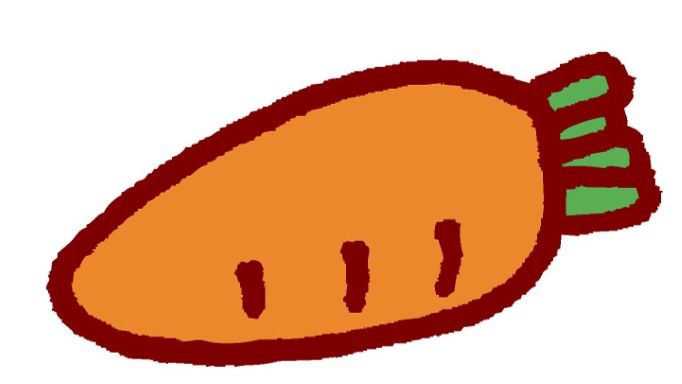
1) get hit by a car: 車に轢かれる
2) ER: emergency room
3) pace: to walk slowly backwards and forwards, especially when you are waiting or worried
4) vegetable: (offensive) an offensive word for a person who is physically alive but not capable of much mental or physical activity, for example because of a serious accident or illness
"Doctor, is my carrot alive? Is it OK?"
The doctor sighs. "I have good news and bad news."
"The good news is your pet carrot is alive."
The man breathes a sigh of relief.
"What's the bad news doctor?"
The doctor looks him in the eyes and says, "Well, I'm sorry but, your carrot's gonna be a vegetable4) for the rest of its life."

1) get hit by a car: 車に轢かれる
2) ER: emergency room
3) pace: to walk slowly backwards and forwards, especially when you are waiting or worried
4) vegetable: (offensive) an offensive word for a person who is physically alive but not capable of much mental or physical activity, for example because of a serious accident or illness
ある男がペットのニンジンを散歩させています。散歩中、ペットは車に轢かれて1)しまいました。救急処置室2)へ駆け込んだ男は、待合室で歩き回って3)いると、手術に疲れ果てた医者が出来る。
「先生、私のニンジンは生きていますか?大丈夫でしょうか?」
「先生、私のニンジンは生きていますか?大丈夫でしょうか?」
医者はため息をつく。「良い知らせと悪い知らせがあります。」
「良い知らせは、あなたのペットのニンジンは命を取り留めたということです。」
男は安堵のため息をつく。
「悪い知らせは何ですか、先生?」
医者は彼の目を見て言った、「残念ですが、あなたのニンジンはこれからの一生を、寝たきりの植物ニンジン4)として生きていくこととなります。」
*
「良い知らせは、あなたのペットのニンジンは命を取り留めたということです。」
男は安堵のため息をつく。
「悪い知らせは何ですか、先生?」
医者は彼の目を見て言った、「残念ですが、あなたのニンジンはこれからの一生を、寝たきりの植物ニンジン4)として生きていくこととなります。」
*
(570) Getup [英単語]
なんです、そのかっこうは!
What's that get-up!?
What's that get-up!?

Doraemon Gadget Cat from the Future

ドラえもん Doraemon ― Gadget cat from the future (Volume 1) Shogakukan English comics
- 出版社/メーカー: 小学館
- 発売日: 2002/02/22
- メディア: コミック
■ eigobu.jp
名詞「getup」の意味
「getup」は「get」と「up」をつなげた1つの名詞です。
「getup」は「奇抜な服装」という意味です。
イギリス英語で、「get up」で「着飾る」という意味があり、それが名詞になっては生まれた単語です。アメリカ英語では「dress up」が普通です。
「getup」は「get」と「up」をつなげた1つの名詞です。
「getup」は「奇抜な服装」という意味です。
イギリス英語で、「get up」で「着飾る」という意味があり、それが名詞になっては生まれた単語です。アメリカ英語では「dress up」が普通です。
■ Cambridge Dictionary
getup noun [C] infml [ˈɡet̬ˌʌp]
The particular clothing, esp. when strange or unusual, that someone is wearing:
He was in a weird getup with a red wig.
赤いカツラをかぶった変な格好だった。
He was in a weird getup with a red wig.
赤いカツラをかぶった変な格好だった。

■ Longman Dictionary
get・up/ˈɡetʌp/noun [countable] informal
a set of clothes, especially strange or unusual clothes
a set of clothes, especially strange or unusual clothes
I hardly recognized him in that getup!
あの格好では、ほとんどわかりませんでした。
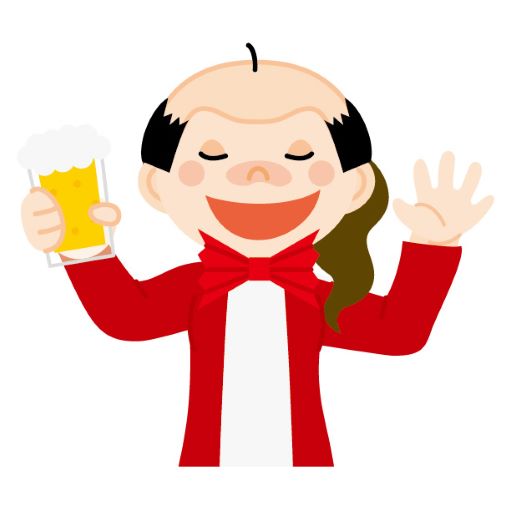
あの格好では、ほとんどわかりませんでした。

■ Wiktionary 日本語版
getup (複数 getups)
身なり、扮装。めったにしない格好。いわゆるコスプレの類
getup (複数 getups)
身なり、扮装。めったにしない格好。いわゆるコスプレの類
You should have seen the Elvis getup he wore to the party!
彼がパーティに着てきたエルヴィスの扮装を君にも見せたかったね。

彼がパーティに着てきたエルヴィスの扮装を君にも見せたかったね。

■ Collinsdictionary
(ˈɡetˌʌp) NOUN informal
1. costume; outfit
Everyone will stare at you if you wear that getup.
そんな格好をしていたら、みんなからじろじろ見られますよ。

そんな格好をしていたら、みんなからじろじろ見られますよ。

*
(569) MUJINA [読書感想]
Last evening, I listened to a radio program in my car. The name of the program is Communication English II for high-school students. A ghost story was read. Its title was MUJINA. It's so famous that I know of the story. I have a book of KWAIDAN (Ghost stories) written by Lafcadio Hearn. The book has MUJINA story. Today I read it, because in yesterday's program the story stopped in the middle.
I learned of a word "rise up"; A woman couching by the moat, slowly rose up.
I didn't get the meaning of gleam in "the gleam of a firefly" when I heard a reading of the story.
I learned of a word "rise up"; A woman couching by the moat, slowly rose up.
I didn't get the meaning of gleam in "the gleam of a firefly" when I heard a reading of the story.
Listen to this
MUJINA
・・・
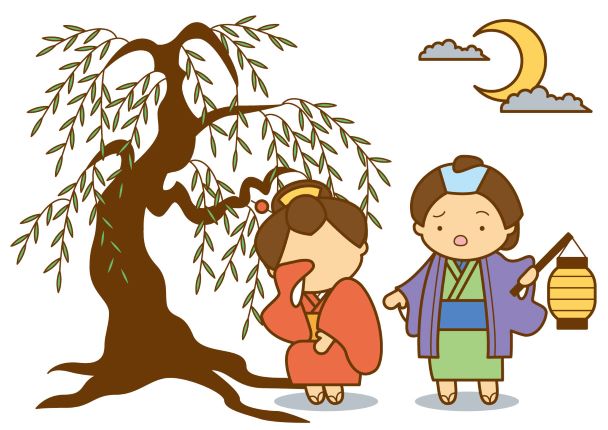
One night, at a late hour, he was hurrying up the Kii-no-kuni-zaka, when he perceived a woman crouching by the moat, all alone, and weeping bitterly. Fearing that she intended to drown herself1), he stopped to offer the any assistance or consolation in his power. She appeared to be a slight2) and graceful person, handsomely dressed; and her hair was arranged like that of a young girl of good family. "O-jochu,"* he exclaimed3), approaching her, ― "O-jochu, do not cry like that!... Tell me what the trouble is; and if there be any way to help you, I shall be glad to help you.4)" (He really meant what he said; for he was a very kind man.) "O-jochu," he said again, as gentle as he could, ー "please, please listen to me!... This is no place for a young lady at night! Do not cry, I implore5) you! ー only tell me how I may be of some help to you!" Slowly she rose up6), but turned her back to him, and continued to moan and sob behind her sleeve. He
MUJINA
・・・

One night, at a late hour, he was hurrying up the Kii-no-kuni-zaka, when he perceived a woman crouching by the moat, all alone, and weeping bitterly. Fearing that she intended to drown herself1), he stopped to offer the any assistance or consolation in his power. She appeared to be a slight2) and graceful person, handsomely dressed; and her hair was arranged like that of a young girl of good family. "O-jochu,"* he exclaimed3), approaching her, ― "O-jochu, do not cry like that!... Tell me what the trouble is; and if there be any way to help you, I shall be glad to help you.4)" (He really meant what he said; for he was a very kind man.) "O-jochu," he said again, as gentle as he could, ー "please, please listen to me!... This is no place for a young lady at night! Do not cry, I implore5) you! ー only tell me how I may be of some help to you!" Slowly she rose up6), but turned her back to him, and continued to moan and sob behind her sleeve. He
*O-jochu ("honourable damsel"), ― a polite form of address used in speaking to a young lady whom one does not know.
laid his hand lightly upon her shoulder, and pleaded7); ー "O-juchu! ー O-jochu! ー O-jochu!... Listen to me, just for one little moment!... O-jochu ー O-jochu!"...
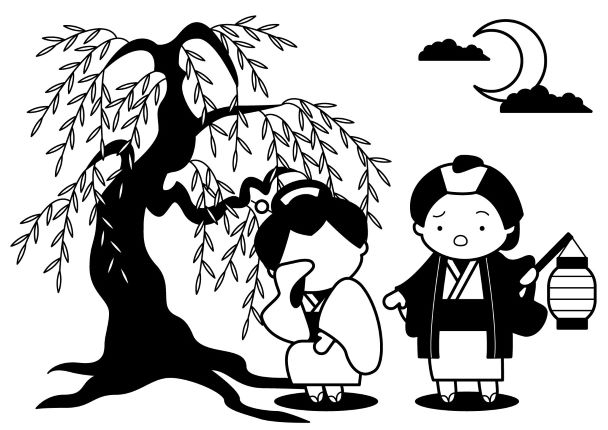
Then that O-jochu turned round, and dropped her sleeve, and stroked her face with her hand; ー and the man saw that she had no eyes or nose or mouth, ー and he screamed and ran away.
Up Kii-no-kuni-zaka he ran and ran; and all was black and empty before him. On and on he ran, never daring to look back; and at last he saw a lantern, so far away that it looked like the gleam of firefly8); and he made for it9). It proved to be only the lantern of an itenerant soba-seller10),* who had set down his stand by the road-side; but any light and any human companionship was good after that experience; and he flung himself down11) at the feet of the soba-seller, crying out, "Aa! ー aa!! ー aa!!!"
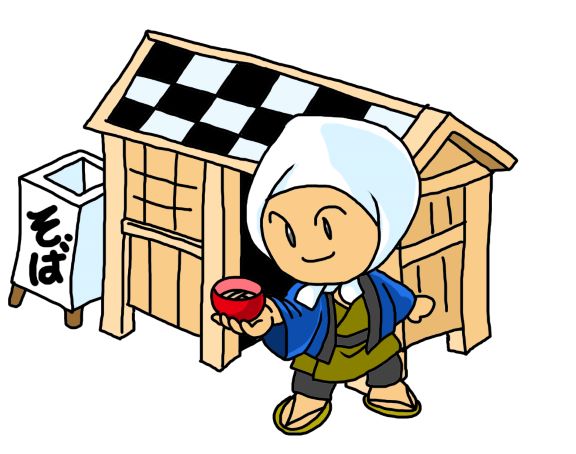
"Koré! Koré!" roughly exclaimed the soba-man. "Here! what is the matter with you? Anybody hurt you?"
* Soba is a preparation12) of buck wheat, somewhat resembling vermicelli13).
12) preparation: 調理、料理
13) vermicelli: バーミセリ、spaghettiより細いパスタ

Then that O-jochu turned round, and dropped her sleeve, and stroked her face with her hand; ー and the man saw that she had no eyes or nose or mouth, ー and he screamed and ran away.
Up Kii-no-kuni-zaka he ran and ran; and all was black and empty before him. On and on he ran, never daring to look back; and at last he saw a lantern, so far away that it looked like the gleam of firefly8); and he made for it9). It proved to be only the lantern of an itenerant soba-seller10),* who had set down his stand by the road-side; but any light and any human companionship was good after that experience; and he flung himself down11) at the feet of the soba-seller, crying out, "Aa! ー aa!! ー aa!!!"

"Koré! Koré!" roughly exclaimed the soba-man. "Here! what is the matter with you? Anybody hurt you?"
* Soba is a preparation12) of buck wheat, somewhat resembling vermicelli13).
12) preparation: 調理、料理
13) vermicelli: バーミセリ、spaghettiより細いパスタ
"No ー nobody hurt me," panted the other, ー "only... Aa! ー aa!..."
"ー Only scared you?" queried14) the pedlar, unsympathetically. "Robbers?"
"Not robbers, ー not robbers," gasped the terrified man. ... "I saw ... I saw a woman -by the moat; - and she showed me ... Aa! I cannot tell you what she showed me!" ...
.jpg)
"Hé! Was it anything like THIS that she showed you?" cried the soba-man, stroking his own face ー which therewith15) became like unto an Egg.... And, simultaneously, the light went out.
"ー Only scared you?" queried14) the pedlar, unsympathetically. "Robbers?"
"Not robbers, ー not robbers," gasped the terrified man. ... "I saw ... I saw a woman -by the moat; - and she showed me ... Aa! I cannot tell you what she showed me!" ...
.jpg)
"Hé! Was it anything like THIS that she showed you?" cried the soba-man, stroking his own face ー which therewith15) became like unto an Egg.... And, simultaneously, the light went out.

KWAIDAN ハーン 怪談 開文社 荻田庄五郎訳注 開文社 1950/1/20
- 作者: ラファカディオ・ハーン
- 出版社/メーカー: 開文社
- 発売日: 2022/09/07
- メディア: 単行本(ソフトカバー)
或る夜、晩くなってから、彼は紀伊の国坂を急ぎ足で上っていた。するとその時、一人の女が唯一人、濠端にしゃがんで悲しげに泣いているのを見た。身投げをする1)積もりでもあろうかと気づかって、出来るだけ何か助けか慰めかになってやろうと思い、彼は立ち止った。彼女はよい身なりをしていて、ほっそりした2)上品な人柄らしく見えた。そしてその髪は、良家の若い娘の髪らしく結われていた。「お女中」と彼はその女に近づきながら叫んだ3)。「お女中、そのように泣くものではありません!...何が心配なのか話して御覧なさい。そうすれば、もしあなたをお助ける方法が何かあれば、私は喜んであなたをお助けしましょう。4)」(彼は、彼がいったことを、ほんとうにする積もりだった。というのは、彼は大変親切な人だったから。)けれども彼女は泣き続けた、--その長い袖の一方で、彼から自分の顔をかくしながら。-「お女中」と彼は出来るだけ優しく、又言葉をかけた。-「どうか、どうか、私のいうことをおききください。...ここは、夜分、若い娘さんのおられる場所ではありません!お願いだから5)泣かないでください!-どうしたら幾分でもあなたのお力になれるかを、いうだけでもいって下さい!」静かに彼女は立ち上がった6)が、彼に背を向けたままで、袖にかくれて悲しみすすり泣きを続けた。彼は自分の手を、彼女の肩の上にそっと置いて頼んだ7)。-「お女中!-お女中!-お女中!...ほんの一寸の間、わたしのいうことをきいて下さい!...お女中ーお女中!」...するとそのお女中が振り向いて、袖をはなし、片手で彼女の顔をなでた。-そこで、その男は見たのだが、彼女は、目も、鼻も、口もなかった。-彼は悲鳴をあげて逃げ出した。
紀伊の国坂を上へ、彼はどんどん走りに走った。前方は真暗で、空(くう)だった。そうしてとうとう、非常に遠方なので、蛍火8)のように見える提灯が眼に入った。そこで彼はそれを目当に進んだ9)。その燈火は、道端に屋台を下していた蕎麦売の10)提燈に過ぎないことが判った。然し、あのような経験をしたあとでは、どんな燈でもどんな仲間でも頼みになった。彼は蕎麦屋の足許に体を投げ出して11)大声で叫んだ。「ああ!-ああ!!-ああ!!!」- 「これ!どうしたんだ。誰かにやられたのか。」
「いいえ、誰も、どうもしたのではない。」彼はあえぎあえぎいったー「だだ...ああ!ーああ!」...
「ーただおどろかされただけなのか」行商人は冷たく尋ねた14)。「追剥か。」
「追剥じゃない、-追剥じゃない。」おびえきった男が、あえぎあえぎいった。...「見たんだ...女を見たんだーお堀端で。- そしてその女が見せたのだ...ああ!何を見せたか、とてもいえない!」
「へえ!その女がお前に見せたのは、こんなものだったか」蕎麦屋が叫んで、自分の顔をなでた。ーそれと共に15)、蕎麦屋の顔は卵の様になった。そして同時に、燈も消えた。
紀伊の国坂を上へ、彼はどんどん走りに走った。前方は真暗で、空(くう)だった。そうしてとうとう、非常に遠方なので、蛍火8)のように見える提灯が眼に入った。そこで彼はそれを目当に進んだ9)。その燈火は、道端に屋台を下していた蕎麦売の10)提燈に過ぎないことが判った。然し、あのような経験をしたあとでは、どんな燈でもどんな仲間でも頼みになった。彼は蕎麦屋の足許に体を投げ出して11)大声で叫んだ。「ああ!-ああ!!-ああ!!!」- 「これ!どうしたんだ。誰かにやられたのか。」
「いいえ、誰も、どうもしたのではない。」彼はあえぎあえぎいったー「だだ...ああ!ーああ!」...
「ーただおどろかされただけなのか」行商人は冷たく尋ねた14)。「追剥か。」
「追剥じゃない、-追剥じゃない。」おびえきった男が、あえぎあえぎいった。...「見たんだ...女を見たんだーお堀端で。- そしてその女が見せたのだ...ああ!何を見せたか、とてもいえない!」
「へえ!その女がお前に見せたのは、こんなものだったか」蕎麦屋が叫んで、自分の顔をなでた。ーそれと共に15)、蕎麦屋の顔は卵の様になった。そして同時に、燈も消えた。
ー 萩田 庄五郎 訳 -
*
*
(568) Carrot's Good News and Bad News [joke]
20s20trimmed.jpg)
Two carrots are walking together down the street1). One of them stepped onto2) the road and ended up3) getting run over4) by a car.
_120s20trimmed.jpg)
The other carrot calls 9115) and they take him to the hospital.
_120s20trimmed.jpg)
After hours of waiting the doctor comes out and says, "I have good news and bad news, the good news is your friend is going to make it6), the bad news is that he's going to be a vegetable7) for the rest of his life."
二本のニンジンがいっしょに通りを歩いている1)。一本が道路にあしを踏み入れてしまい2)、結局3)車にひかれてしまった4)。もう一本のニンジンは救急車5)を呼び、病院へ連れて行った。何時間も待たされたあと、医者が出てきて、こう言った、「良いニュースと悪いニュースがあります、良いニュースは、あなたの友人は助かりそうだということです6)、悪いニュースは彼は今後、一生、植物人間7)になってしまうということです。」
1) down the street: along/down/up the street
2) onto: used with verbs to express movement on or to a particular place or position
She stepped down from the train tonto the platform.
3) end up: to find yourself in a place or situation at the end of a process or period of time end up doing something / I ended up doing all the work myself.
4) run over: (of a vehicle or its driver) to knock a person or animal down and drive over their body or a part of it / Two children were run over and killed. My dog almost got run over.
5) 911: the phone number used in the US to call the police, fire or ambulance services in an emergency
6) make it: to survive after a serious illness or accident; do deal successfully with a difficult experience / The doctors think he's going to make it.
7) vegetable: (offensive) an offensive word for a person who is physically alive but not capable of much mental or physical activity, for example because of a serious accident or illness
*
*
(567) Marathon vs 100m run [thought]
(1) Life is a marathon, so what's the use of coming in first for just 100 meters?
I often hear of similar quotes, and this reminds me of a Japanese phrase 一生懸命. I understand it as working hard for a lifetime.
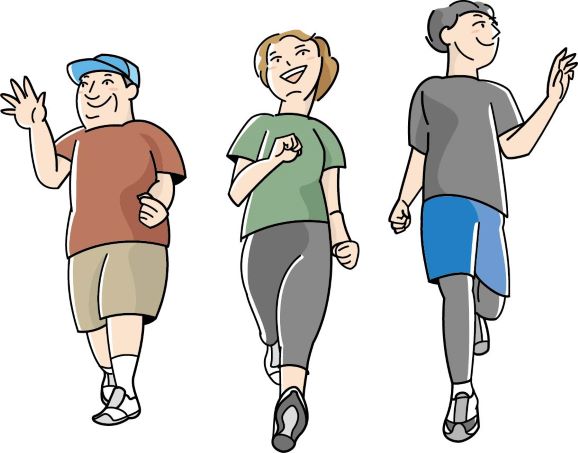
My question is whether life is a marathon for everybody. The answer is no. Because I've found the next quote from a web site, Marathon Quotes.
(2) Life is often compared to a marathon, but I think it is more like being a sprinter; long stretches of hard work punctuated by brief moments in which we are given the opportunity to perform at our best.
長い間懸命に努力し、その間に最高のパフォーマンスを発揮できる瞬間がある。
長い間懸命に努力し、その間に最高のパフォーマンスを発揮できる瞬間がある。
Who said this? Michael Johnson did. Who is he? He is an American retired sprinter who won four Olympic gold medals and 8 World Championships gold medals in the span of his career. He worked very hard for being a sprint. This reminds me another Japanese phrase, 一所懸命. This originally means "Work hard in one place," and means work hard for one thing.


These two quotes (1) and (2) say about opposite things, the marathon and the sprint. Which is more important for people to win a marathon or a 100m sprint? We cannot compare these two different kinds of races. Both are equally important at last.
By the way, who said the quote (1)?
Taizo Ishizaka (1886-1975) did. He is a Japanese who served as chairman of Keidanren [Japan Business Federation] for 12 years.
What is life's goal?

It varies from person to person. For Michael Johson, being a sprinter was his life's goal. Then being a sprinter is as important as life is a marathon. Because importance doesn't depend on the length of races and lifetime. And Japanese 一所懸命 and 一生懸命 are now used in the same way, as work hard.
*
Taizo Ishizaka (1886-1975) did. He is a Japanese who served as chairman of Keidanren [Japan Business Federation] for 12 years.
人生はマラソンなんだから、100メートルで一等をもらったってしょうがない。
石坂泰三(1886-1975) 経団連
His quote can be rephrased like this, "I want to aim for victory at my life's goal, not be happy or sad about immediate success." He wanted to aim for victory at his life's goal.石坂泰三(1886-1975) 経団連
What is life's goal?

It varies from person to person. For Michael Johson, being a sprinter was his life's goal. Then being a sprinter is as important as life is a marathon. Because importance doesn't depend on the length of races and lifetime. And Japanese 一所懸命 and 一生懸命 are now used in the same way, as work hard.
*
タグ:ことわざ
(566) Nagasaki Kirishitan Rutakuhi Monument [調べる]
Please look at this picture. It reads Nagasaki Kirishitan Rutakuhi, meaning Nagasaki Christian exile Monument. The obelisk style monument is 3.5m high.
The front of the pedestal1) is bordered and engraved with the names of the eight dead. In front of this, two small old tombstones are enshrined.
1) pedestal: (円柱・彫像の)台座
The inscription says: in October of the first year of Meiji (AD 1868), more than 3,000 of us were exiled from Nagasaki for being Catholics. More than 100 of us were exiled to Matsuyama. We endured three and a half years of hard labor, including being forced to apostatize2) in a three-foot prison, during which time eight of us returned to heaven.
2) apostatize: (信仰、党などを)捨てる、脱する
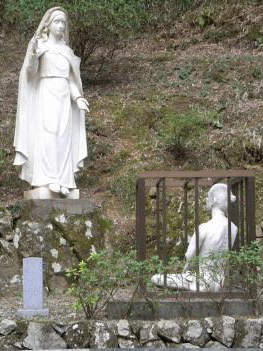 REPLICA THREE-FOOT PRISON
REPLICA THREE-FOOT PRISON(The statue of Yasutaro in the replica "three-foot prison" installed at Otome Pass in Shimane prefecture and the statue of the Virgin Mary who descended.)
I was shocked to know of the monument because this exile occurred in the Meiji era. I knew tortures against Christians in the Edo era, about 400 years ago. The system of shogunate was based on the class system. It ranks Samurai at the top, followed by peasants, craftsmen and merchants. The Christian principle of equality didn't go with this rank system. The new government, Meiji government abolished the class system of the Edo period, and ensured the equality of all people. But it took five more years to abolish the prohibition of Christianity. In 1873, it was done because of the pressure from foreign countries, not of understanding freedom of religion.
The reality of these tortures against Christians was reported in Western countries through foreign missions. This led to an outpouring3) of international public opinion. It harshly condemned4) the Meiji government for oppressing5) believers of the same religion as themselves.
3) outpouring: (感情の)ほとばしり
4) condemn: 責める、避難する
5) oppress: ・・・を迫害する
3) outpouring: (感情の)ほとばしり
4) condemn: 責める、避難する
5) oppress: ・・・を迫害する

Nighnteen years later, in 1892, the 24th year of the Meiji, an American came to Matsuyama as an English teacher of the Japanese government Middle school. He was a Methodist, kind of Protestant. He wrote in his diary about Roman Catholic Christians of the Edo period in Japan.
He said, "It seems, however, that much of the evil that befell these early Roman Catholic Christians resulted from the effort to establish Christianity as the State religion."
I think, he wanted to say that even Christianity should not be the State religion.
Lastly, I am happy to say this.
Today's Japan's constitution mentions about freedom of religion. Article 20. Freedom of religion is guaranteed to all. No religious organization shall receive any privileges from the State, nor exercise any political authority.
信教の自由は、何人にたいしてもこれを保障する。いかなる宗教団体も、国から特権を受け、又は政治上の権力を行使してはならない。
*
(565) Listen in Peanuts (1) [英単語]

A good friend is someone who will listen to you. Snoopy listens to Sally. He tried to hear every word she says. He pays attention to what she is saying. It's nice to be listened to. "Thank you for listening, Snoopy," Sally says.
--- Charlie Brown Dictionary ---
Example 1-1
Peppermint Patty is calling Charlie in the midnight.
_120s.jpg) |
_120s.jpg) |
| (1)もしもし、チャック・・起こしてごめんね、でも眠れないの・・ | (2)近頃いろんなことで頭の中がいっぱいなのよ・・・ |
_120highlighted20s.jpg) |
_120s.jpg) |
| (3)あなたに話したいの、いつもいい聞き手だから・・ | (4)グー |
Example 1-2
Spike is listening to a rock in the desert.
_120highlighted20s.jpg) |
| 荒れ地にこうして座り込んで、岩の話す彼の一生を聞いているなんて我ながら信じられないな・・ |
_120s.jpg) |
| 彼女の一生だった、失礼・・ |
Example 1-3
1-Kings chapter 18 verse 26
_120s.jpg) |
|
(1)先生なんて言ったの、マーシー?
(2)列王記上18章の26から引用したんです・・
|
_1highlighted20s.jpg) |
|
(3)しかし、声もなく、答える者も、聞く者もなかった。
(4)鋭いですね。先生・・
|
https://bible.usccb.org/bible/1kings/18
26 Taking the young bull that was turned over to them, they prepared it and called upon Baal from morning to noon, saying, "Baal, answer us!" But there was no sound, and no one answering. And they hopped around the altar they had prepared.
*
(564) GADOUHITORIGEIKO [調べる]
Today, I'd like to introduce an old book. This book is for children who want to learn drawing. Katsushika Hokusai, one of famous Ukiyoe artists made this book. I got to know of this book from a guide leaflet of Shiki Museum. Masaoka Shiki was born in Matsuyama about 150 years ago. He was a leading haiku poet. When he was small, he liked drawing and painting pictures. He begged his mother to learn to paint, but she would not allow it. So, he tried to learn drawing by himself. When he was 11 years old, he copied the whole book of "GadoHitoriGeiko" (画道独稽古) borrowed from a friend. This title of the book means teach yourself how to draw pictures. Here are Shiki's copy and the original.
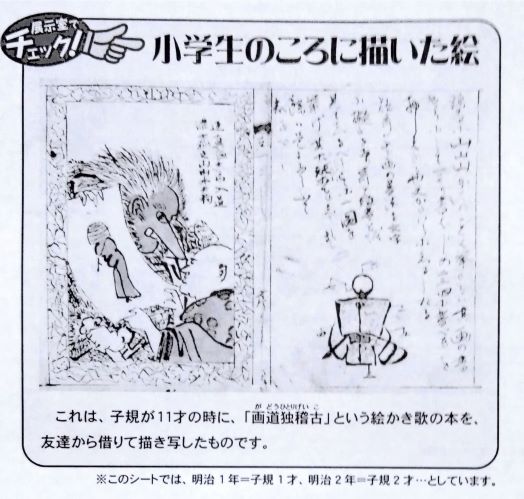

I got interested in this book, so I will talk about this. This page explains how to use this book.
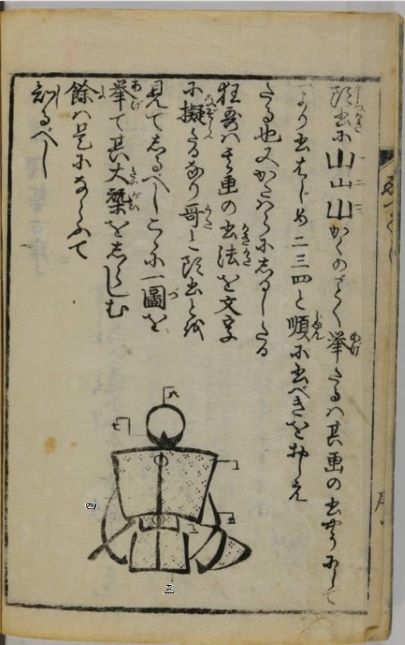
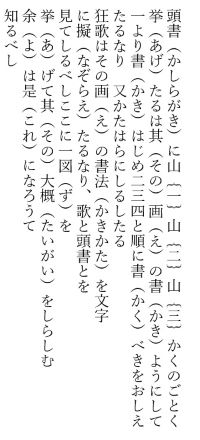
The reason why these Chinese characters of mountain(山)in the head note, are numbered first(一), second(二), and third(三) is to show how the picture should be drawn.
The Kyoka poem written next to the picture instructs how to draw the picture with characters. Please look at the poem and the notes at the top to understand. Here is a picture as an example to give you an overview. Use this as a reference to understand the instructions of other pictures.


The reason why these Chinese characters of mountain(山)in the head note, are numbered first(一), second(二), and third(三) is to show how the picture should be drawn.
The Kyoka poem written next to the picture instructs how to draw the picture with characters. Please look at the poem and the notes at the top to understand. Here is a picture as an example to give you an overview. Use this as a reference to understand the instructions of other pictures.
Turning pages, I found the samurai's page.


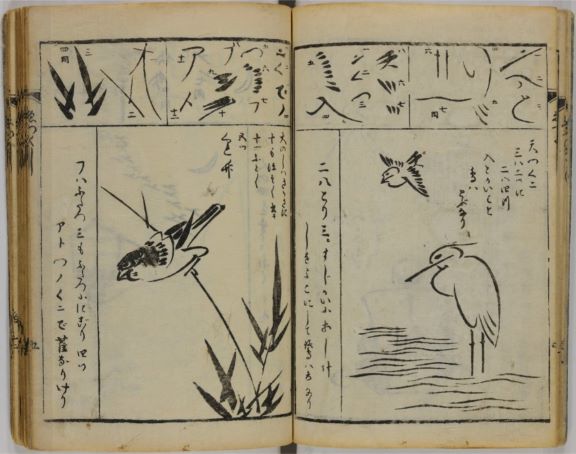
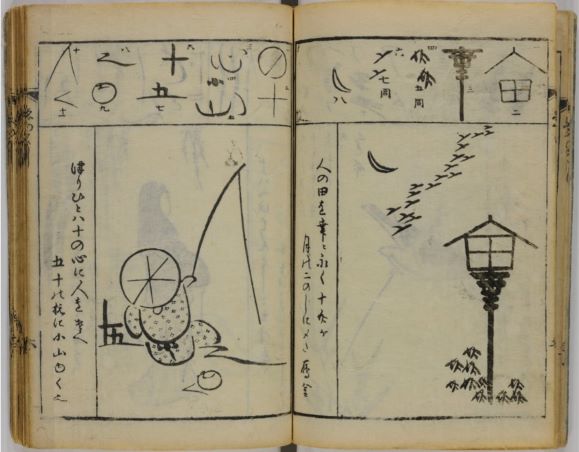
These show that this book consists of quick lessens in simplified drawings.




These show that this book consists of quick lessens in simplified drawings.
This page shows how to draw a samurai. In the head note two sets of drawings parts. These parts are characters. All of them are numbered. If you start drawing each part in order. You can finish the picture of a samurai looking at Mt. Fuji with two cranes flying over. There are two Kyoka poems. One is the instruction for drawing Mt. Fuji and cranes. The other is for the samurai sitting on his heels.
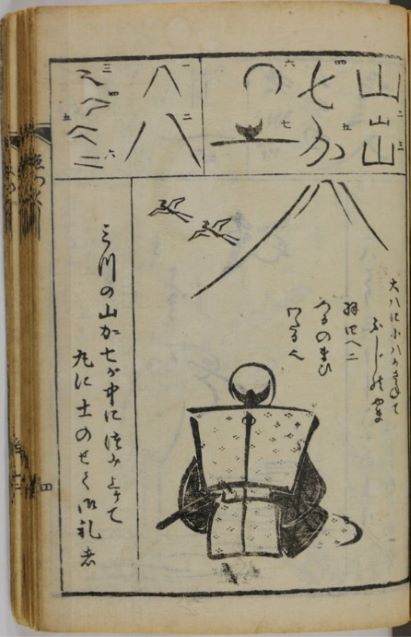

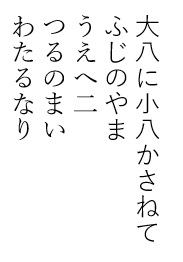
DAIHACHINI
SHOHACHIKASANETE
FUJINOYAMA
UEHENITSURUNO
MAIWATARUNARI



DAIHACHINI
SHOHACHIKASANETE
FUJINOYAMA
UEHENITSURUNO
MAIWATARUNARI
Putting the small eight on the big eight
Mt. Fuji appears
Two cranes are flying away
Mt. Fuji appears
Two cranes are flying away
MITSUNOYAMA
KASHICHIGANAKANI
TUMIAGETE
MARUNITSUCHINOSE
MIRUOREIMONO
Three mountains(山) are piles up
Between two characters of ka(か) and seven(七)
Adding the character of soil(土) on a circle
Makes a polite samurai surveying the view
*
Between two characters of ka(か) and seven(七)
Adding the character of soil(土) on a circle
Makes a polite samurai surveying the view
*
(563) Nocturnal leg cramps [読解]
.jpg)
I read a study about nocturnal leg cramps, which was done by University Medical Center Groningen, Groningen University the Netherlands. The answer to this question, "Does stretching before sleep reduces the frequency and severity of nocturnal leg cramps in older adults?" was yes. Nightly stretching before going to sleep reduces the frequency and severity of nocturnal leg cramps in older adults.
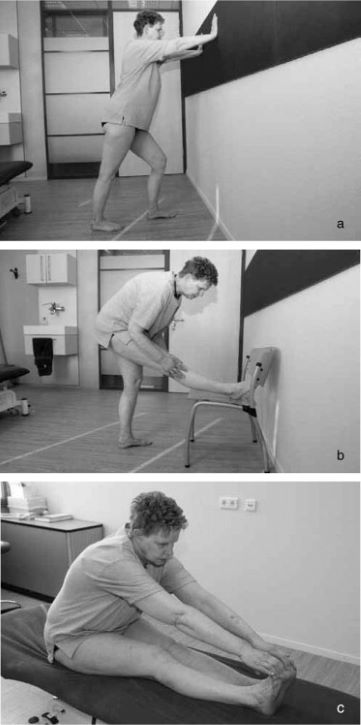
Stretches used in the experimental group; (a) calf stretch in standing, (b) hamstring stretch in standing, (c) hamstring and calf stretch in sitting.
I tried stretches before sleep, but I did Makkouhou (真向法) stretching instead. I did it for less than 3 minutes.
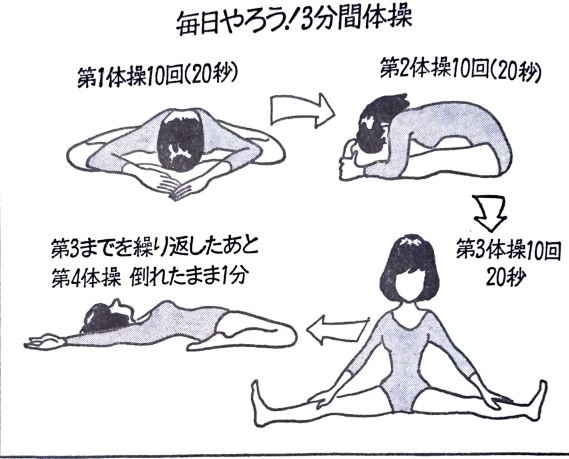
So far, I have done these stretches before sleep for about a week. It works, I think.

So far, I have done these stretches before sleep for about a week. It works, I think.
Introduction
Nocturnal leg cramps are suddenly occurring, episodic1), painful, sustained, involuntary muscle contractions of the calf muscles, hamstrings2), or foot muscles. During the cramp, the involved muscles are tender and hard on palpation3). The pain that occurs with these contractions is sharp and intense and may last from seconds to several minutes. Although they are otherwise benign4), nocturnal leg cramps can cause substantial5) distress6) and can disrupt7) sleep. In 20% of people who experience nocturnal leg cramps, cramps also occur during the daytime (Monderer et al 2010). The cramps sometimes occur in episodes a few days a week, during which they repeat themselves (Kanaan and Sawaya, 2001, Stewart et al 1993, Mondere et al 2010). Although the insults8) generally persist for no longer than ten minutes, in exceptional situations they can continue for several hours. In approximately 2% of cases, nocturnal leg cramps occur weekly (Abkulla et al 1999). Nocturnal leg cramps occur more commonly with advancing age, affecting between 38% and 50% of the elderly (Butler et al 2002, Abulla et al 1999, Sotag and Wanner, 1988). Nocturnal leg cramps are more prevalent9) among women and among people with comobidities10), especially those with neurological11) and cardiovascular12) diseases (Butler et al 2002, Stewart et al 1993).
1) episodic: 時折起こる
2) hamstring: 人間のひざの後ろの腱
3) palpation: 触診
4) benign: [bɪnάɪn] 良性の
5) substantial: plentiful 相当な
6) distress: suffering 苦悩
7) disrupt: 中断する
8) insults: 発作
9) prevalent: はやっている
10) comorbidity: 共存症
11) neurological: 神経性の
12) cardiovascular: 循環器系の
1) episodic: 時折起こる
2) hamstring: 人間のひざの後ろの腱
3) palpation: 触診
4) benign: [bɪnάɪn] 良性の
5) substantial: plentiful 相当な
6) distress: suffering 苦悩
7) disrupt: 中断する
8) insults: 発作
9) prevalent: はやっている
10) comorbidity: 共存症
11) neurological: 神経性の
12) cardiovascular: 循環器系の
Stretching before sleep reduces the frequency and severity of nocturnal leg cramps in older adults. A randomized trial
Question
In adults who experience nocturnal leg cramps, does stretching of the calf and hamstring muscles each day just before sleep reduce the frequency and severity of the cramps?
In adults who experience nocturnal leg cramps, does stretching of the calf and hamstring muscles each day just before sleep reduce the frequency and severity of the cramps?
Design
A randomised trial with concealed13) allocation14) and intention-to-treat analysis15).
13) concealed: 隠した
14) allocation: 割り当て、配置
15) intention-to-treat: ITT分析、包括解析
A randomised trial with concealed13) allocation14) and intention-to-treat analysis15).
13) concealed: 隠した
14) allocation: 割り当て、配置
15) intention-to-treat: ITT分析、包括解析
Participants
Eighty adults aged over 55 years with nocturnal leg cramps who were not being treated with quinine16).
16) quinine: kwάɪnɑɪn(米国英語), kwɪníːn(英国英語)、キニーネ剤(マラリア特効薬)
Eighty adults aged over 55 years with nocturnal leg cramps who were not being treated with quinine16).
16) quinine: kwάɪnɑɪn(米国英語), kwɪníːn(英国英語)、キニーネ剤(マラリア特効薬)
Intervention17)
The experimental group performed stretches of the calf and hamstring muscles nightly, immediately before going to sleep, for six weeks. The control group18) performed no specific stretching exercises. Both groups continued other usual activities.
17) intervention: 治療介入
18) control group: 操作を加えないままにしてあるグループ
The experimental group performed stretches of the calf and hamstring muscles nightly, immediately before going to sleep, for six weeks. The control group18) performed no specific stretching exercises. Both groups continued other usual activities.
17) intervention: 治療介入
18) control group: 操作を加えないままにしてあるグループ
Outcome measures
Participants recorded the frequency of nocturnal leg cramps in a daily diary. Participants also recorded the severity of the pain associated with nocturnal leg cramps on a 10-cm visual analogue scale. Adverse events were also recorded.
Participants recorded the frequency of nocturnal leg cramps in a daily diary. Participants also recorded the severity of the pain associated with nocturnal leg cramps on a 10-cm visual analogue scale. Adverse events were also recorded.
Results
All participants completed the study. At six weeks, the frequency of nocturnal leg cramps decreased significantly more in the experimental group, mean difference 1.2 cramps per night, (95% CI19) 0.6 to 1.8). The severity of the nocturnal leg cramps had also decreased significantly more in the experimental group than in the control group, mean difference20) 1.3 cm (95% CI 0.9 to 1.7) on the 10-cm visual analogue scale.
19) 95% CI: 95%confidence interval 95%信頼区間20) mean difference: 治療群の数値の平均値とコントロール群の数値の平均値の差
All participants completed the study. At six weeks, the frequency of nocturnal leg cramps decreased significantly more in the experimental group, mean difference 1.2 cramps per night, (95% CI19) 0.6 to 1.8). The severity of the nocturnal leg cramps had also decreased significantly more in the experimental group than in the control group, mean difference20) 1.3 cm (95% CI 0.9 to 1.7) on the 10-cm visual analogue scale.
19) 95% CI: 95%confidence interval 95%信頼区間20) mean difference: 治療群の数値の平均値とコントロール群の数値の平均値の差
Conclusion
Nightly stretching before going to sleep reduces the frequency and severity of nocturnal leg cramps in older adults.
Trial registration
NCT01421628
*
Nightly stretching before going to sleep reduces the frequency and severity of nocturnal leg cramps in older adults.
Trial registration
NCT01421628
*
(562) 鶯宿梅 Oushukubai [詩歌]
鶯宿梅(Oushukubai) I saw this word a hauta song Harusame. Its lyrics were written by Shibata Hanamori about 170 years ago. An unnamed prostitute put a tune to this poem. I learned Harusame in my shamisen lessen. I like this melody. There are several performances of Harusame in YouTube.
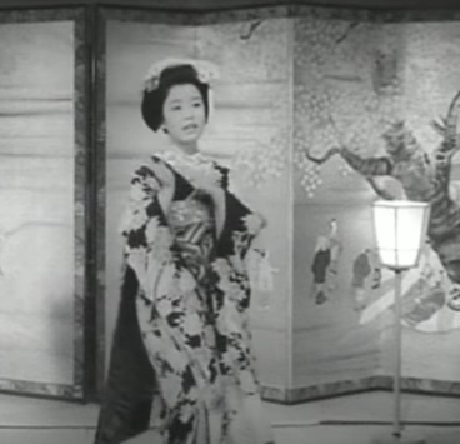
My favorite one is Misora Hibari's dancing scene in a samurai movie. She was dancing in kimono and singing to the shamisen, a banjo-like instrument with three strings. She sang that she is uguisu the Japanese nightingale, the one she loves is the plum tree. I couldn't understand love between a nightingale and a plum tree. I am a little confused because I imagined several nightingales in a plum tree. The expression 鶯宿梅(oushukubai) nightingale's-home-plum tree was quite new to me. But the other day I learned a famous old waka poem and its anecdote.
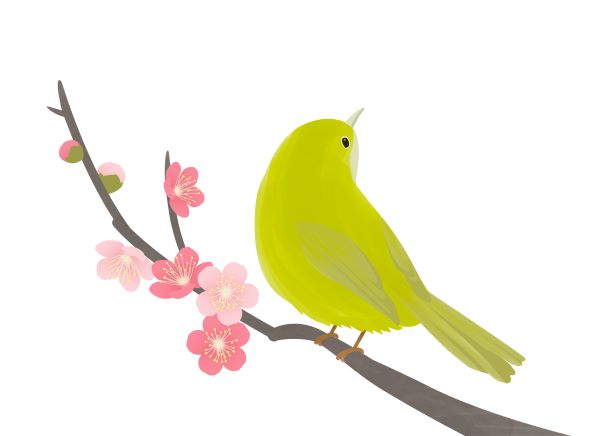

My favorite one is Misora Hibari's dancing scene in a samurai movie. She was dancing in kimono and singing to the shamisen, a banjo-like instrument with three strings. She sang that she is uguisu the Japanese nightingale, the one she loves is the plum tree. I couldn't understand love between a nightingale and a plum tree. I am a little confused because I imagined several nightingales in a plum tree. The expression 鶯宿梅(oushukubai) nightingale's-home-plum tree was quite new to me. But the other day I learned a famous old waka poem and its anecdote.

The next short story explains what 鶯宿梅(oushukubai) is. It goes like this;
(The emperor had a red-blossoming plum tree very dear to him. It died, and his minister was sent to seek and get a tree like it. At last, one was found and asked of the lady who owned it. She loved the plum tree for its blooms, and because a nightingale would come there and sing; but she could not deny since it was the order of the emperor. When the tree was taken away, she tied to it a little paper, upon which was written:
(The emperor had a red-blossoming plum tree very dear to him. It died, and his minister was sent to seek and get a tree like it. At last, one was found and asked of the lady who owned it. She loved the plum tree for its blooms, and because a nightingale would come there and sing; but she could not deny since it was the order of the emperor. When the tree was taken away, she tied to it a little paper, upon which was written:
Chioku nare ba itomo Kashiikeshi 勅なればいともかしこし
Uguisu no Yado wato towaba 鶯の宿はと問わば
Ikaga kota yen. いかが答へむ
”As it is the order of the emperor, I am filled with awe; but if am asked where is the home of the nightingale, what shall I answer?" The emperor, touched by the verse, returned the plum tree.)
ーTwenty Months in Japan by H. G. Hawkinsー
Uguisu no Yado wato towaba 鶯の宿はと問わば
Ikaga kota yen. いかが答へむ
”As it is the order of the emperor, I am filled with awe; but if am asked where is the home of the nightingale, what shall I answer?" The emperor, touched by the verse, returned the plum tree.)
ーTwenty Months in Japan by H. G. Hawkinsー
This incident happened more than 1,000 years ago in Kyoto in Japan. This plum tree is called oushukubai, which means Japanese nightingale's-home tree.
Now I return to the hauta song, Harusame. I try to understand the meaning of these lyrics.
春雨に しっぽり濡るるうぐいすの
Harusame ni shippori nururu Uguisuno
Harusame ni shippori nururu Uguisuno
羽風に匂う梅が香や
Ha-kaze ni Niou Ume ga Ka ya
Ha-kaze ni Niou Ume ga Ka ya
花に戯れ しおらしや
Hana ni tawamure shiorashiya
Hana ni tawamure shiorashiya
小鳥でさえも一筋に
Kotori de saemo Hitosuji ni
Kotori de saemo Hitosuji ni
ねぐら定めぬ 気はひとつ
Negura sadamenu Ki wa hitotsu
Negura sadamenu Ki wa hitotsu
私しゃ鶯 主は梅
Watasha Uguisu Nushi wa Ume
Watasha Uguisu Nushi wa Ume
やがて 身まま気ままになるならば
Yagate mimama kimama ni narunaraba
Yagate mimama kimama ni narunaraba
サアー 鶯宿梅じゃないかいなー
Saa Oushuku Bai ja naikai naa
Saa Oushuku Bai ja naikai naa
サアーサ 何でもよいわいな
Saasa nan demo yoiwai naa
A Japanese nightingale gets wet moistly in the spring rain
The fragrance of plum blossoms wafting fragrantly in the breeze of feathers
The lovely nightingale playing in the plum blossoms
Even such a fragile little bird
Has its roost firmly set
And lives in the plum tree sincerely
Saasa nan demo yoiwai naa
A Japanese nightingale gets wet moistly in the spring rain
The fragrance of plum blossoms wafting fragrantly in the breeze of feathers
The lovely nightingale playing in the plum blossoms
Even such a fragile little bird
Has its roost firmly set
And lives in the plum tree sincerely
I am the nightingale, you are the plum tree
Someday I will be free
If I am free to do as I please
Then I'll fly to you, my home of the plum tree
Oh, it doesn't matter anymore
Oh, I don't care anymore
*
Someday I will be free
If I am free to do as I please
Then I'll fly to you, my home of the plum tree
Oh, it doesn't matter anymore
Oh, I don't care anymore
*





